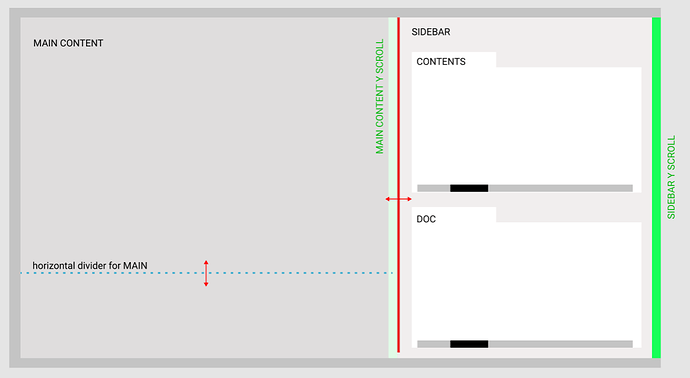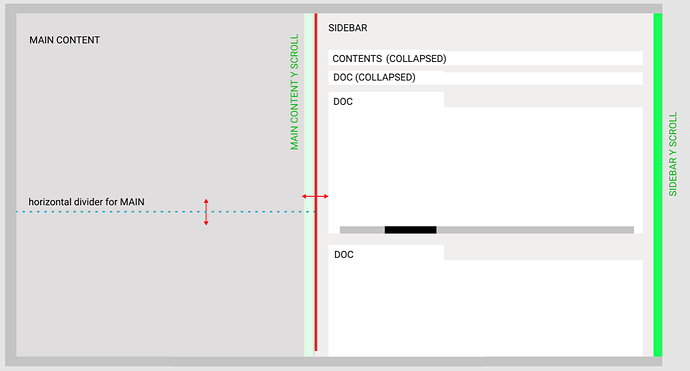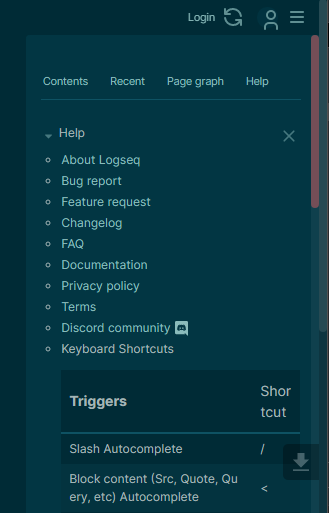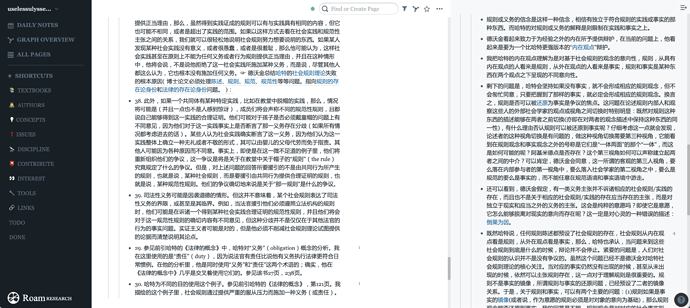曾记得 @tiensonqin ten 在 Discord 上说过有此计划, @anoffvu 也曾极力推荐。我觉得这个并无必要,下面是我一点设想,供您和其他开发同仁参考:
当我提到obsidian的并行多窗口挤压模式存在文本位置会不断被改变的严重问题时,有朋友则直接指出并行多窗口挤压模式不好,而偏爱浏览器的多标签窗口独占模式,我的基本想法如下:
- 并行窗口有无必要?对于笔记软件当然有必要。当整理第一层次/阶段的a笔记时,我们需要方便地同时看到或编辑第二层次/阶段的b笔记。
- 挤压模式好不好?挤压模式是并行窗口的必然结果,所以既然接受并行窗口,就没有好不好的问题,但是,如果处理不好文本位置,就会变成一个极大的麻烦,使得并行窗口这个优点变成弱点。
- 如果优化文本位置问题,并行多窗口挤压模式好吗?可以想见,即使改善了文本位置的问题,挤压式仍然不那么令人满意,这是该模式固有的问题。有理由主张,任何笔记的窗口都最好不要被在横向挤压,而可以在纵向限制显示长度。
- 并行多窗口的逻辑是不是有什么问题?并行多窗口的逻辑是,所有的笔记对于当前的编辑和阅读者来说都是地位平等的,于是即使一个窗口被固定,也只是避免被其他多开窗口取代,但无法避免被挤压空间(横向挤压实际等于被缩放窗口)。
- 我们的笔记编辑和阅读执行的是并行逻辑吗?不是。在同一时刻阅读和编辑笔记时,一般而言,有“编辑区-参照区”、“主要文献阅读区-其他文献参照区”等这样的“主要-辅助”结构。这个结构有两个要点:1.它的层次没那么多,不是像并行多窗口那样平等对待n多窗口;2.它区分主要和次要两个大区域,并且在在两个大区域(特别是次要大区域)内以上下挤压而非左右挤压的方式多开窗口,并且可以将这些窗口内的笔记在主次区域切换。可以看到,这其实是 RR 式双栏多窗口非挤压式的设计原则。
- 双栏多窗口模式有什么特点?最大的特点就是保证了主次大区域的空间的稳定,其次是保证在大区域内打开的小窗口不被左右挤压,而左右挤压的问题就在于会改变文本位置,即使这个问题经过优化,也不如上下挤压那样来的好。
- 总结:(1)并行多窗口挤压模式一定有其特别的好处,但处理不好就会造成极大的麻烦;因此,既然这是ob的特色,就把这个特色做好,不要把这个特色变成负担。(2)一般而言,我们的笔记活动需要的是简单的主次窗口区域,而不是对n多的笔记窗口都平等对待的并行窗口,当然肯定不要多标签窗口独占这样的陈旧模式。
I remember @tiensonqin ten saying this on Discord and @anoffvu highly recommending it. I don’t think this is necessary, but here are a few ideas for you and your fellow developers:
When I mentioned the serious problem with Obsidian’s parallel multi-window extrusion mode where text placement is constantly changing, and a friend pointed out that parallel multi-window extrusion mode is bad and prefers the browser’s multi-tabbed window exclusive mode, my basic idea is as follows:
- Is a parallel window necessary? It is certainly necessary for note-taking software. When organizing the A notes of the first level/stage, we need to easily see or edit the B notes of the second level/stage at the same time.
- Is the extrusion mode good? Extrusion mode is a natural consequence of parallel windows, so there is no problem with accepting parallel windows, but if text placement is not handled well, it can become a huge inconvenience, turning the advantage of parallel windows into a weakness.
- If we optimize the text location problem, is the parallel multi-window extrusion mode good? As we can imagine, even with improved text placement, extrusion mode is still less than satisfactory, which is an inherent problem with this pattern. It is reasonable to argue that the window of any note should not be squeezed in the landscape, but should be limited in the portrait.
- Is there a problem with parallel multi-window logic? The logic of parallel multi-windows is that all notes are equal to the current editor and the reader, so even if a window is fixed, it can only avoid being replaced by other multi-open windows, but it cannot avoid being squeezed (horizontal squeezing is actually the same thing as a scaled window).
- Do our note editing and reading perform parallel logic? It isn’t. In general, when reading and editing notes at the same time, there are “major-auxiliary” structures such as “editing area - reference area”, “main literature reading area - other literature reference area” and so on. This structure has two main points: (1). It does not have so many layers and does not treat n multiple Windows equally like parallel multiple Windows; (2). It distinguishes two large areas, the main area and the secondary area. In two large areas (especially the secondary area), more windows are opened by squeezing above and below instead of squeezing left and right, and the notes in these windows can be switched between the primary and secondary areas. As we can see, this is actually the design principle of RR type double column multi-window non-extrusion type.
- What are the characteristics of the two-column multi-window mode? The biggest characteristic is to ensure the stability of the space of the primary and secondary large areas, and the second is to ensure that the small window opened in the large area is not squeezed left and right, and the problem of left and right squeezing is that it will change the text position, even if the problem is optimized, it is not as good as the upper and lower squeezing.
- Summary : I have emphasized above that (1) the advantages and disadvantages of the primary and secondary binary structure and the parallel N-element structure for note-taking, but not for everything; (2) I do not deny the advantages of the parallel N-element structure, but it may be a disadvantage if it is not handled well and the basic functions are not well played when choosing this mode. Taking notes is a very focused and slow thing, not a massive, quick window opening or a K-chart.(1) Parallel multi-window extrusion mode certainly has its special benefits, but it can cause great trouble if handled poorly. (2) Generally speaking, we need a simple primary and secondary window area for note-taking activities, rather than a parallel window that treats more than n notes’ window equally. Of course, we certainly don’t want to monopolize such an old pattern of multiple tabbed windows.






